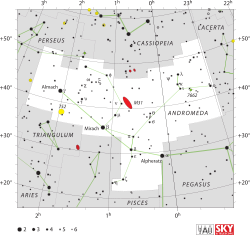| Observation data Epoch J2000 Equinox J2000 | |
|---|---|
| Constellation | Andromeda |
| Right ascension | 01h 27m 39.38072s[1] |
| Declination | +45° 24′ 24.0651″[1] |
| Apparent magnitude (V) | +4.83[2][3] |
| Characteristics | |
| Spectral type | F5 IVe[4] or F3 V + F5 V[5] |
| U−B color index | +0.00[3] |
| B−V color index | +0.42[3] |
| Astrometry | |
| Radial velocity (Rv) | +14.7[2] km/s |
| Proper motion (μ) | RA: 357.564(127)[1] mas/yr Dec.: −110.039(118)[1] mas/yr |
| Parallax (π) | 34.7332 ± 0.1341 mas[1] |
| Distance | 93.9 ± 0.4 ly (28.8 ± 0.1 pc) |
| Absolute magnitude (MV) | +2.57[2] |
| Details | |
| ω And A | |
| Mass | 0.963±0.049[5] M☉ |
| Radius | 2.2[6] R☉ |
| Luminosity | 7.1[7] L☉ |
| Temperature | 6,628[7] K |
| Metallicity [Fe/H] | −0.16[2] dex |
| Rotational velocity (v sin i) | 57.1[8] km/s |
| Age | 2.1[2] Gyr |
| ω And B | |
| Mass | 0.860±0.051[5] M☉ |
| Other designations | |
| Database references | |
| SIMBAD | data |
Omega Andromedae (ω And, ω Andromedae) is the Bayer designation for a slowly co-rotating[failed verification] binary star system[9] in the northern constellation of Andromeda. Parallax measurements made during the Gaia mission make this system to be approximately 93.9 light-years (28.8 parsecs) from Earth. Its apparent visual magnitude is +4.83,[2] which makes it bright enough to be seen with the naked eye.
The primary component has a stellar classification of F5 IVe.[4] The IV luminosity class indicates that it is probably a subgiant star that is in the process of evolving away from the main sequence as the supply of hydrogen at its core depletes. However, Abt (1985) gives a classification of F3 V, suggesting it is an F-type main-sequence star.[5] The measured angular diameter of the primary star is 0.70 ± 0.03 mas.[10] At the system's estimated distance this yields a size of about 2.2 times that of the Sun.[6] It is emitting about seven times solar luminosity from its outer atmosphere at an effective temperature of 6,628 K.[7] This heat gives it the yellow-white-hued glow of an F-type star.[11]
In 2008, the companion star was resolved using adaptive optics at the Lick Observatory. Later observations showed the magnitude difference between the two stars is 3.65 ± 0.03 and they are separated by 0.669 arcsecond.[9] Abt (1985) lists the class as F5 V.[5]
- ^ a b c d e Cite error: The named reference
Gaia EDR3was invoked but never defined (see the help page). - ^ a b c d e f Cite error: The named reference
aaa418_989was invoked but never defined (see the help page). - ^ a b c Cite error: The named reference
clpl4_99was invoked but never defined (see the help page). - ^ a b c Cite error: The named reference
SIMBADwas invoked but never defined (see the help page). - ^ a b c d e Cite error: The named reference
Farrington2014was invoked but never defined (see the help page). - ^ a b Cite error: The named reference
lang2006was invoked but never defined (see the help page). - ^ a b c Cite error: The named reference
aaa405_723was invoked but never defined (see the help page). - ^ Cite error: The named reference
aaa493_3_1099was invoked but never defined (see the help page). - ^ a b Cite error: The named reference
apj698_1_28was invoked but never defined (see the help page). - ^ Cite error: The named reference
aaa431_773was invoked but never defined (see the help page). - ^ Cite error: The named reference
csirowas invoked but never defined (see the help page).
